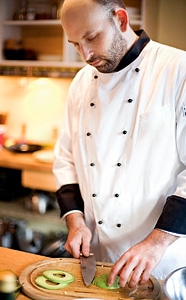How To Live At Sea
Think living on an island sounds like a dream? Imagine living on two islands. Or three. Or better yet, a five-star yacht that stops on islands around the world from the Caribbean to the South Pacific. That's the life of Seth Rosenberg, 40, a former New York City handyman who traded his tool belt for chef's whites and wound up an island-hopping private chef on yachts. We talked to Seth to find out how he made his way from the big city to the even bigger sea — and why you should never ever try to steam a coconut crab.
Q: How did you become a yacht chef?
A: Through friends I met a woman who worked as a chef on yachts. I couldn't believe there was a job like this: live on a yacht, cook, travel, make lots of money. I had been a restaurant chef years ago, but I got out of the business because I hated restaurants, not the cooking. Being a yacht chef sounded amazing from the moment I heard it was a job. But like every fantasy, the reality has been much more hard work.
Q: How is cooking on a boat different from cooking at a restaurant?
A: One of the biggest drawbacks is using an electric stove. Another challenge is getting fresh dairy and produce because the shelf life is short. The island might be out of milk. There is always boxed milk, but it's never first rate. There are also stringent import laws on some islands. When I was in the Pacific, I was on the phone for hours and hours with purveyors; no one could get the food to me that I needed. Finally, the boss brought in his own food; it kind of had to be smuggled. And you might be able to buy sweet potatoes, mangoes and onions on any island. But parsley? Cilantro? It's all flown in.
Q: With that in mind, on which island is it best to buy groceries?
A: St. Martin has one of the best supermarkets, Le Grand Marché. You can get anything, from pomegranates to caviar to fresh truffles. If I walk into a market with my uniform on, I get treated like royalty because yachts can spend $5,000 to $10,000 a week on food. I can even have some- one push the cart!
Q: So how does the menu change depending on the island you're on?
A: I've made conch fritters and conch salad in the Bahamas and ice cream with soursop, a sweet fruit that grows in the Caribbean. In American Samoa, there is all the fresh tuna you could ever want to eat, so I've made fresh tuna sushi and sashimi. New Caledonia is awesome. It's a French island, so there are imports from France, such as foie gras. I even made beautiful filet mignon in Vanuatu. The cows are all out to pasture in coconut fields.
Q: Sounds delicious. Does the menu ever not exactly work out according to plan?
A: I've had my fair share of disasters. On Vanuatu, I tried to make steamed coconut crab, a huge, monster crab, and it turned into a cauldron of yellow, bubbly mess; everyone was gagging from the smell. I didn't serve that.
Q: What do you miss most about your mainland existence?
A: The biggest challenge to moving around from island to island is keeping track of the currency as well as the phone service; it's difficult provisioning for the boat. You sail from St. Martin to St. Thomas, and your phone doesn't work anymore — you need to change the SIM card. There are several currencies in St. Martin alone. They take dollars almost everywhere, but the change is in local currency, so you might be getting ripped off a couple of bucks every time.
Q: But you must have had some pretty awesome island adventures, right?
A: I've wandered through many local island markets looking for food; I've seen the most beautiful clear water in the Exumas. With the natives of Vanuatu, I drank kava, a mind-altering drink made of pepper-plant root mixed with water. It's like the national sport. I just had two cups of the stuff, which looks and tastes like dirty water, and I was wasted! They drink it in these big thatched-roof huts with a group of about 30 guys. Everyone's mouth goes numb, so they spit into buckets; you feel splatters on your ankles.
Q: What is your favorite island region?
A: The Caribbean. Everything is so close together, and there is great diversity: Creole, French, Spanish, Dutch, English, American. The weather is always great. The Baths on Virgin Gorda is one of the most beautiful places I've ever seen. It's a huge natural stone formation of caves, like a lab- yrinth, with shallow tide pools running through. The light streams in and is reflected off the water. But my favorite island is New Caledonia in the middle of the Pacific. It's very cosmopolitan, has a European feel with fantastic restaurants — French-style cafes with tropical twists. There is lots of nightlife. And my favorite bar there is La Bodega. Its deck sits right over the ocean. I failed French three times, but somehow when I was there, I managed to speak it better than I ever needed to. If I could figure out a way to move to New Caledonia, I would.
Q: Would you say you feel like you're living the island dream?
A: Every day! Even on my worst days doing this, I'm thinking that building houses or being a gar- bage man is hard work. I have tough days, but I'm on a luxury yacht in the middle of a beautiful place, and I'm aware of it every day.
